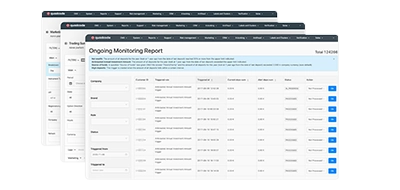Volver
Contents
¿Qué son las opciones binarias?

Iva Kalatozishvili
Business Development Manager

Demetris Makrides
Senior Business Development Manager
Las opciones binarias son un derivado que permite a los operadores proyectar y predecir la dirección del movimiento del precio de un activo durante un período determinado. El término "binario" se deriva de los dos posibles resultados de la transacción: perderá su dinero si el pronóstico es incorrecto y obtendrá ganancias si es correcto. La simplicidad de las opciones reside en la única responsabilidad del operador: decidir si el valor de un activo subyacente —ya sea una acción, una divisa o una materia prima— subirá o bajará al vencimiento.
Cómo funcionan las opciones binarias
Operar con opciones binarias es sencillo, pero exige un análisis preciso del mercado y una capacidad de cálculo preciso de los tiempos. Este enfoque consiste en seleccionar un activo subyacente y predecir si su precio superará o caerá por debajo de un punto específico, conocido como precio de ejercicio, en una fecha futura. El plazo de vencimiento de estas predicciones puede variar desde un minuto hasta varias horas o incluso días.
Si cree que una acción subirá en la próxima hora y compra una opción de compra sobre ella, y su predicción es correcta al vencimiento, recibirá una cantidad fija. Normalmente, esta será entre el 70 % y el 90 % de su inversión inicial. Pero si el precio baja o no alcanza su objetivo, perderá el dinero invertido en esa acción. La estructura básica del trading de opciones —la posibilidad de elegir entre solo dos resultados posibles— es lo que suele atraer a los inversores; sin embargo, es fundamental reconocer el mayor riesgo que conllevan estas transacciones.
Tipos de opciones binarias
Actualmente, existen varios tipos de opciones binarias con diversos métodos de predicción y niveles de riesgo disponibles en el mercado. Uno de los tipos más populares es la opción "call o put", en la que se apuesta a si el precio de un activo subirá (opción call) o bajará (opción put) en relación con el precio de ejercicio al llegar a su fecha de vencimiento. Otras variantes utilizadas incluyen:
- Opciones táctiles/sin táctilesEn estos escenarios, los operadores predicen si el precio del activo alcanzará un nivel (lo tocará) antes de la fecha límite. El operador obtiene ganancias si el precio alcanza o evita tocar el nivel establecido durante el plazo designado, según su predicción.
- Opciones de rangoAl usar opciones de rango, los operadores realizan proyecciones sobre si el valor de un activo se mantendrá dentro de un rango hasta el vencimiento o si lo superará por completo. La ganancia depende de si el precio se mantiene dentro de los límites establecidos.
Los distintos tipos de opciones binarias ofrecen diversas formas de realizar operaciones comerciales y permiten a los operadores alinear sus tácticas con las condiciones predominantes del mercado.
Opciones binarias vs. CFD vs. Forex: ¿Cuál es la diferencia?
Conocer las diferencias entre opciones binarias , CFD Forex puede ayudarte a elegir la mejor manera de operar, según tus objetivos y el nivel de riesgo que te resulte cómodo. Aquí tienes un vistazo rápido a cómo se comparan.
| Característica | Opciones binarias | CFD | Forex |
| Estructura de resultados | Establecer victoria/derrota | Las ganancias y pérdidas pueden cambiar | Las ganancias y pérdidas pueden cambiar |
| Aprovechar | Ninguno | A menudo utiliza un alto nivel de apalancamiento | Alto apalancamiento disponible |
| Riesgo | Alto (todo o nada) | Alto | Alto |
| Término de tiempo | Minutos a horas | Día a día o más tiempo | Generalmente de corto a mediano plazo |
| Vigilancia | A menudo no mucho | Generalmente bien regulado | Regulado en grandes mercados |
| Ganancia | Limitado | Sin límite | Ilimitado |
| Mercados | Pocos activos | Muchos (acciones, índices, criptomonedas, etc.) | Principalmente divisas |
| ¿Qué tan complejo? | Fácil | Medio a alto | Medio |
Ventajas de las opciones binarias
Las opciones binarias han ganado popularidad por diversas razones que tanto operadores como inversores comprenden bien. La principal es su facilidad de negociación en comparación con otras estrategias, que suelen requerir un profundo conocimiento de los mercados financieros y habilidades de análisis técnico. Las opciones binarias ofrecen un enfoque mucho más sencillo. Simplemente predicen si el precio de un activo subirá o bajará en un plazo específico. Esta simplicidad las hace atractivas y accesibles para principiantes o personas con poca experiencia en trading, ya que no requieren dominar herramientas o estrategias financieras complejas.
Otra ventaja significativa es la claridad en el riesgo y la recompensa al operar con opciones. La configuración de pagos se mantiene constante; por lo tanto, los operadores tienen una idea clara de sus posibles ganancias o pérdidas antes de ejecutar una operación. Esta sencilla relación riesgo-recompensa elimina la incertidumbre y ayuda a los operadores a tomar decisiones bien pensadas sin preocuparse por movimientos repentinos del mercado o fallos inesperados. Las opciones binarias ofrecen un entorno controlado para la gestión del riesgo, en comparación con las herramientas financieras que pueden implicar márgenes de ganancia o pérdida erráticos e inciertos.
La rápida ejecución de las opciones puede atraer a los operadores que buscan aprovechar las fluctuaciones del mercado. Con las opciones binarias, es posible cerrar muchas operaciones en un día, ya que sus plazos de vencimiento varían de minutos a horas. Si desea aprovechar las oportunidades del mercado sin comprometerse con inversiones a largo plazo, pero busca rentabilidad inmediata, la rotación rápida es la mejor opción.
Para las personas con agendas ajustadas o para aquellos que disfrutan de participar activamente en actividades comerciales, las opciones binarias presentan un enfoque interactivo para la participación en el mercado y ofrecen el potencial de obtener ganancias financieras regulares.
Riesgos y desafíos de las opciones binarias
Las opciones binarias pueden parecer sencillas a simple vista, pero en realidad conllevan riesgos sustanciales que pueden resultar en pérdidas si no se manejan con cuidado. La naturaleza binaria de estas opciones implica que una predicción incorrecta podría resultar en la pérdida de la inversión inicial. Mientras que con otros métodos de trading es posible obtener ganancias o pérdidas parciales, las opciones binarias no ofrecen esa protección: se trata de una ganancia total o de una pérdida total del monto invertido, o todo o nada. Gestionar los riesgos es crucial en situaciones de alto riesgo, ya que una serie de pérdidas puede agotar rápidamente el saldo de la cuenta.
La naturaleza rápida y a corto plazo de las opciones binarias puede facilitar la obtención de resultados rápidamente; sin embargo, también dificulta la toma de decisiones precisas debido al impacto de las rápidas fluctuaciones del mercado causadas por actualizaciones de noticias, desarrollos económicos imprevistos o cambios en la confianza de los inversores en períodos cortos. Por lo tanto, los operadores deben estar preparados para la volatilidad del mercado, que puede dificultar la predicción sin una investigación técnica detallada.
Las opciones binarias se promocionan con frecuencia como operaciones de bajo riesgo, lo que lleva a los operadores a creer que las ganancias serán fáciles. Esta idea no se cumple en la práctica, ya que operar con éxito con opciones binarias exige un profundo conocimiento de las tendencias del mercado y un enfoque disciplinado en la ejecución de las operaciones. Muchas personas se lanzan al trading sin investigar adecuadamente ni diseñar una estrategia sólida. Esta falta de preparación puede resultar en importantes reveses financieros. Al igual que en cualquier tipo de trading, el éxito nunca está garantizado y la posibilidad de pérdidas financieras acecha constantemente y es un peligro omnipresente.
Otra preocupación importante es el riesgo de encontrarse con corredores fraudulentos, no regulados o sin licencia en el mercado de opciones binarias, que carece de regulaciones estrictas en comparación con otros sectores financieros. Para abordar este problema eficazmente y protegerse de los riesgos, las prácticas comerciales desleales o la manipulación por parte de estos corredores, los operadores deben investigar exhaustivamente a los corredores potenciales y verificar su licencia con una autoridad financiera acreditada. Operar con corredores no regulados puede generar complicaciones, como la imposibilidad de recibir fondos o su malversación, lo que introduce un riesgo adicional que los operadores deben tener en cuenta.
Opciones binarias: ¿Dónde son legales? Un vistazo al mundo
La legalidad de las opciones binarias depende en gran medida de dónde vivas. En algunos lugares las aceptan si se vigilan de cerca. En otros, las han prohibido por completo por temor a las estafas y a proteger el dinero de los usuarios.
- Unión Europea: Si operas habitualmente en la UE, las opciones binarias están prohibidas debido a las normas de la ESMA. Solo los operadores profesionales de renombre pueden operar a través de brókeres con licencia.
- Estados Unidos - En EE. UU., solo se puede operar legalmente con opciones binarias a través de plataformas reguladas, como NADEX y Cantor Exchange. La CFTC las supervisa.
- Reino Unido - Incluso después del Brexit, la FCA sigue diciendo no al comercio de opciones binarias, en línea con los estándares de la UE.
- Australia: Es legal operar aquí, y la ASIC establece las normas. Sin embargo, es necesario usar plataformas que la ASIC ha autorizado. En 2021, la ASIC impuso algunas restricciones para garantizar la seguridad de los operadores habituales.
- Sudáfrica: Las opciones binarias son legales y la FSCA está a cargo. Sin embargo, no las supervisan tan de cerca como en Europa.
- Rusia y países de la CEI: Muchos países que formaban parte de la Unión Soviética no tienen normas sobre opciones binarias. Esto significa que podrías tener problemas fácilmente con corredores que no las siguen o intentan engañarte.
- Oriente Medio y Asia: La situación es mixta. En países como Japón, las opciones binarias son legales, pero están sujetas a numerosas normas. En otros, como India o Malasia, este mercado no está regulado o está totalmente prohibido.
Antes de registrarte con un bróker, asegúrate de que tenga las licencias correctas y esté supervisado por las personas adecuadas. Si operas con una plataforma no regulada, estás poniendo en riesgo tu dinero. Podrías terminar con precios injustos o no poder retirar tu dinero.
Opciones binarias: mitos y realidades
Las opciones binarias parecen sencillas, pero la gente se equivoca constantemente. Muchos operadores nuevos se lanzan al mercado por la publicidad exagerada o la desinformación, lo que genera expectativas poco realistas. Aclaremos algunos malentendidos comunes con la realidad:
| Mito | Realidad |
| Las opciones binarias son dinero fácil | Para operar de forma rentable es necesario investigar el mercado, calcular bien los tiempos y tener un plan sólido. |
| No puedes perder mucho | Puedes perder todo tu dinero si haces una sola mala predicción. |
| Todos los corredores binarios son legítimos | Los reguladores no supervisan los lotes. Verifique siempre que su corredor cuente con la autorización de una autoridad financiera. |
| Es como jugar a las apuestas | El trading se basa en el buen razonamiento, no solo en el azar. Tu éxito depende de la habilidad, no de la suerte. |
| Las operaciones a corto plazo son más seguras | Las operaciones rápidas pueden ser más riesgosas debido a los cambios del mercado. |
Creer en estos mitos puede arruinar tus finanzas, especialmente si eres un operador principiante que se deja llevar por las conversaciones sobre dinero rápido. Lo cierto es que operar con opciones binarias, como cualquier juego de adivinanzas del mercado, requiere preparación, concentración y saber cómo usar lo que tienes.
Además, es fundamental conocer la diferencia entre un bróker regulado y uno no regulado. Los que no lo están pueden ofrecer grandes bonificaciones y rentabilidades poco realistas, pero no suelen protegerte si algo sale mal. Siempre verifica la licencia del bróker y compruébala con autoridades como la CySEC, la ASIC o la FCA.
Si los traders saben qué es real, pueden avanzar en el trading de opciones binarias con los ojos bien abiertos y obtener mejores resultados.
Cómo elegir un bróker confiable
Elegir un buen corredor de opciones binarias es fundamental. Busca una plataforma abierta, que pague de forma justa y que mantenga tu dinero seguro. Busca lo siguiente:
1. ¿Están regulados?
Quédate con corredores que estén supervisados por las autoridades, como:
- CySEC (Chipre)
- ASIC (Australia)
- FSCA (Sudáfrica)
Estas licencias significan que tienen que cumplir las reglas, lo que lo protege de estafas.
2. Pagos claros
Un bróker de confianza muestra claramente el porcentaje de pago de cada operación antes de su ejecución. Debes saber cuánto puedes ganar o perder sin términos ocultos.
3. Confiabilidad de la plataforma
La plataforma de trading debe ser fluida, rápida y fácil de usar. Las plataformas lentas o confusas pueden arruinar tus operaciones y costarte dinero.
4. Practica con cuentas demo
Encuentra un corredor con una cuenta demo gratuita. Es una forma de probar sin invertir dinero real.
5. Retiros fáciles
Los buenos corredores te permiten retirar tu dinero rápidamente y sin problemas. Siempre deberías poder acceder a tus fondos sin problemas.
Mejores prácticas para el trading
Para obtener excelentes resultados en el trading de opciones binarias, es fundamental seguir las estrategias recomendadas, como desarrollar un plan, limitar los riesgos y seleccionar un bróker confiable. Aquí tienes algunas recomendaciones detalladas para ayudarte a navegar eficientemente en el mercado de opciones:
1. Desarrollar una estrategia comercial sólida
Si desea tener éxito operando con opciones binarias, necesita un plan de trading. Antes de operar con cualquier producto, asegúrese de investigarlo a fondo desde una perspectiva tanto técnica como fundamental. Patrones en los gráficos de precios y indicadores Instrumentos como las medias móviles, las bandas de Bollinger y el índice de fuerza relativa (RSI) forman parte del análisis técnico. Con estos instrumentos, se pueden identificar mejor las tendencias, las situaciones de sobreextensión o infravaloración, y los cambios de tendencia. Al analizar activos, es fundamental mantenerse al día con las actualizaciones económicas y los resultados de las empresas, ya que estos pueden afectar los precios, junto con los acontecimientos geopolíticos y la percepción general del mercado.
Al operar con opciones binarias, es fundamental elegir el marco temporal de negociación adecuado según la investigación de mercado y la evaluación de la volatilidad de los activos. Las opciones a corto plazo son ideales para quienes buscan aprovechar las fluctuaciones de precios, mientras que las opciones a largo plazo ofrecen más tiempo para el análisis y ayudan a mitigar los efectos de las fluctuaciones del mercado.
2. Backtesting y Paper Trading
El backtesting y el trading en papel son pasos iniciales necesarios antes de invertir dinero en un sistema. Al comparar el rendimiento de su estrategia con datos históricos (backtesting), podría encontrar debilidades o ajustar sus puntos de entrada y salida. Por otro lado, puede probar su técnica de trading en condiciones reales de mercado mediante el trading en papel, también conocido como trading en cuenta demo. Puede ganar confianza antes de operar con dinero real utilizando cualquiera de estos métodos, lo que le mostrará la eficacia de su estrategia.
3. Enfatizar la gestión de riesgos
Cada transacción en el trading de opciones tiene consecuencias de todo o nada, por lo que una buena técnica de gestión de riesgos es esencial. Una estrategia eficaz consiste en limitar la inversión en cada transacción a un máximo del 1% al 2% del saldo total de su cuenta. De esta forma, protege su cartera de cualquier posible pérdida. Incluso con una estrategia ganadora, es posible experimentar rachas de pérdidas; por lo tanto, proteger su capital con controles de riesgo es clave para la sostenibilidad a largo plazo en el trading.
Otra forma eficaz de gestionar el riesgo es establecer límites de pérdidas. A pesar de que las opciones tienen fecha de vencimiento, se pueden adoptar estrategias eficaces de gestión del riesgo estableciendo límites de pérdidas mentales o modificando el nivel de actividad según las circunstancias del mercado. Por ejemplo, si observa que su estrategia de trading falla durante periodos de mayor volatilidad, reducir el volumen de sus transacciones o tomarse un breve descanso puede ayudarle a evitar pérdidas innecesarias.
4. Domina la disciplina emocional
En el trading de opciones, dominar el control emocional es crucial. La naturaleza vertiginosa del mercado puede desviar a los operadores, llevándolos a tomar decisiones precipitadas que los perjudican a largo y corto plazo. Tras una serie de malas operaciones, los operadores a veces ceden a la tentación de intentar recuperar las pérdidas asumiendo mayores riesgos. Por el contrario, los operadores pueden confiarse demasiado y aumentar su apetito por el riesgo durante rachas ganadoras. Mantenga el rumbo independientemente de los resultados anteriores; la constancia es clave en su enfoque. Siga sus principios de gestión de riesgos para proteger su inversión a largo plazo.
5. Mantenga un diario de operaciones
Una práctica importante, aunque a menudo descuidada, es llevar un diario de operaciones donde se anotan los detalles de cada operación, como el activo negociado y su fecha de vencimiento, junto con los motivos para operar y el resultado obtenido. Algunos operadores no llevan un diario porque la bolsa suele tener un historial de sus operaciones. Sin embargo, llevar un registro de todas sus operaciones le ofrecerá información sobre su rendimiento a lo largo del tiempo y le permitirá detectar patrones recurrentes en sus estrategias o identificar áreas donde puedan estar cometiendo errores. Lleve su diario constantemente para ajustar su estrategia eficazmente y evitar dejarse llevar por las emociones, mientras se mantiene enfocado en lograr el éxito financiero a largo plazo.
6. Aprendizaje continuo y adaptación
Los mercados financieros están en constante cambio. Las tácticas que tuvieron éxito en el pasado podrían no serlo en el futuro. Para mantenerse competitivo, es importante seguir aprendiendo. Manténgase informado sobre las novedades del mercado siguiendo las noticias y leyendo informes. Participe también en comunidades de trading para mantenerse al tanto de las estrategias, tendencias y cambios en las condiciones del mercado. La adaptabilidad es crucial para el éxito en opciones, ya que la dinámica del mercado cambia rápidamente debido a nueva información económica o eventos geopolíticos.
Glosario de opciones binarias
¿Te confunden algunos términos que se usan en el trading? Aquí tienes una guía rápida para ayudarte a comprender los conceptos clave de las opciones binarias:
- Opción de compra: ¿Cree que el precio de un activo subirá? Una opción de compra implica apostar a que el precio será superior a un precio fijo (precio de ejercicio) al vencimiento de la opción. Si acierta, ¡ganará dinero!
- Opción de venta: ¿Cree que el precio de un activo bajará? opción de venta Es una apuesta a que el precio será inferior al precio de ejercicio al vencimiento de la opción. Si el precio baja como esperabas, ¡ganas!
- Precio de ejercicio: este es el precio que el activo debe superar (para una opción de compra) o superar (para una opción de venta) para que usted gane la operación.
- Tiempo de Caducidad: Es cuando finaliza la opción binaria y cuando verifican si estabas en lo cierto o no. Puede ser tan breve como 30 segundos o tan largo como días; depende de tu estrategia.
- En el dinero / Fuera del dinero:
- In the Money (ITM): Adivinaste bien. Te pagan.
- Fuera del Dinero (OTM): Te equivocaste. Pierdes el dinero que invertiste.
Conocer estos términos puede ayudarte a tomar decisiones más inteligentes al operar y evitar perder dinero por malentendidos. Si no sabes qué significan, podrías malinterpretar lo que está sucediendo y realizar operaciones arriesgadas.
Conclusión
Operar con opciones ofrece un enfoque sencillo, aunque algo arriesgado, para operar en el mercado de diversos activos financieros. Los operadores pueden aprovechar la posibilidad de obtener ganancias rápidas utilizando este sencillo modelo de predicción de sí/no, pero deben ser conscientes de los importantes riesgos que conlleva. Una investigación exhaustiva, una planificación estratégica y una buena gestión de riesgos son factores clave para abordar eficazmente la complejidad del trading de opciones binarias.
FAQ
Son legales en algunos lugares, pero otros los han prohibido o les han impuesto límites porque son algo arriesgados. Por lo tanto, siempre consulte las leyes de su lugar de residencia y asegúrese de que el corredor tenga una licencia de un grupo confiable.
Claro que puedes ganar dinero, pero necesitas un buen plan, conocer el mercado y ser cuidadoso con tu dinero. Muchos operadores nuevos pierden dinero debido a la característica de todo o nada de las opciones binarias.
El depósito mínimo varía según el corredor, pero suele rondar entre $10 y $250. Algunos sitios incluso tienen cuentas falsas para que puedas probar a operar sin usar fondos reales.
Si bien las opciones binarias se basan en un simple sí o no, para ganar en operaciones es necesario conocer el mercado, realizar análisis técnicos y saber elegir el momento adecuado, no solo esperar tener suerte.
Puedes ver lo que sucede en breve, quizás en un minuto o en unas horas, porque las operaciones pueden terminar rápidamente. ¡Pero eso también lo hace mucho más arriesgado!
Actualizado:
4 de julio de 2025




